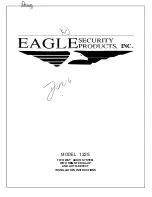
Emergency Switch
No modifications are required to use the optional emergency switch. Re-
fer to the connection diagram for wiring details.
External And Remote Internal Speakers
No modifications are required to use a single external speaker with the
radio (a horn speaker is configured as an external speaker). If a remote inter-
nal speaker is used in addition to the external speaker, the radio jumper con-
figuration must be changed. See Table 1, Figure 3, and the connection
diagram for details.
Figure 3 - Speaker Wiring
8
Bypass Ignition Switch
The bypass ignition switch option allows the radio to be operated at all
times. In this configuration, the ignition switch may be turned off and the ra-
dio will continue to operate. Refer to Table 1, the connection diagram, and
the power cable installation section of this manual.
RUNNING CABLES
To assure the feasibility of the cable routes you plan to use, it is sug-
gested that you run the cables before installing the radio. Be sure to leave
some slack in each cable so that the radio may be pulled out for servicing
with the power applied.
Try to route the cables away from locations where they will be exposed
to heat (exhaust pipes, mufflers, tailpipes, etc.), battery acid, sharp edges, or
mechanical damage, or where they will be a nuisance to automobile mechan-
ics, the driver, or passengers. Keep wiring away from ignition circuits to
help prevent noise pickup in the radio equipment.
In addition, try to utilize existing holes in the fire wall and trunk wall and
the channels above or beneath the doors. You may also use the channels
through door and window columns, where they are convenient, unless you
plan to install rigid or flexible conduit in which to run the cables.
The yellow ignition sense lead (part of power cable) must be con-
nected to A+ before the radio can be programmed.
NOTE
Figure 4 - Typical Cable Routing
9


































